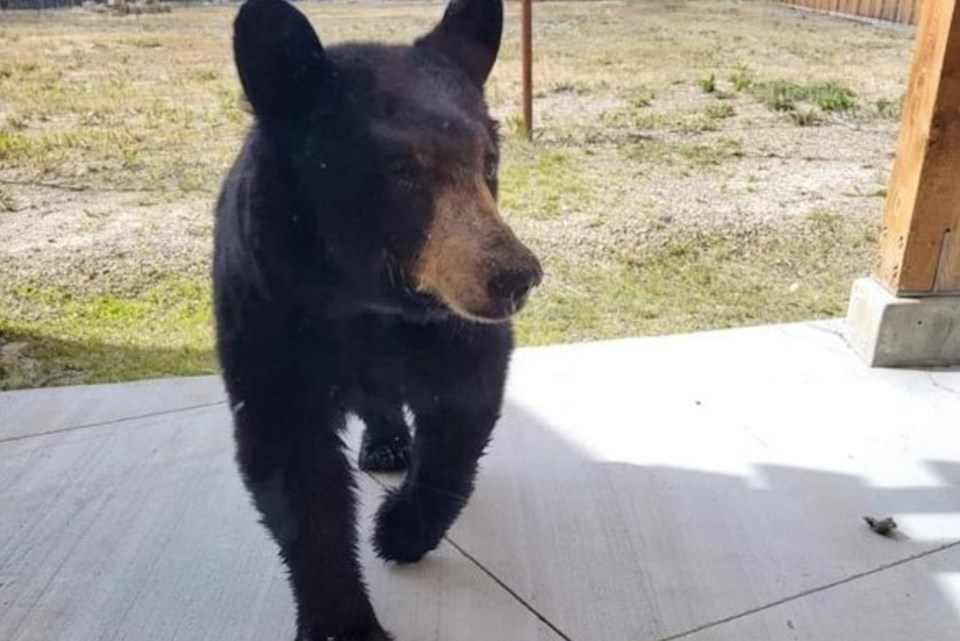A bear that was euthanized in the early morning of Oct. 17 in Fireside had simply pushed through the boundaries of habituation – it just got too comfortable around humans.
In this case, the bear had grown comfortable enough to fall asleep between two houses in Fireside, napping after a meal of tasty household garbage it had happily stumbled upon.
Alberta Fish and Wildlife officers first darted the bear to immobilize it, then moved it to an enclosure before they euthanized it, as the animal was considered a public safety risk.
Fish and Wildlife personnel from different geographical areas have been responding to calls from neighbouring jurisdictions even more than usual this year, as call volumes are on the up. Calgary-area Fish and Wildlife officer Matt Michaud said in his eight years on the job, he’s never seen higher numbers of calls reporting bears near settled urban areas than this year.
Michaud was called out to respond to another bear encounter in Cochrane earlier this month, when a black bear startled kids as it ran across residents’ lawns in the Riverview neighbourhood.
“The kids waiting at the bus stop saw a different bus coming, and they jumped onto the one that pulled up to another stop,” Michaud said.
Attempts were made to trap that bear, with no success.
“Once they have access to all that garbage, it gets harder and harder to lure them into a trap,” Michaud said.
He wouldn’t speculate on whether the bear euthanized in Fireside Oct. 17 could be the same bear sighted roaming around Riverview in the weeks prior.
“You’d need DNA to determine that, and we don’t normally collect DNA,” he said.
Michaud also said it was beyond his expertise to speculate on where these bears might be locating their dens for the winter.
Relocation is always a challenge, as bear behaviour experts like the people behind Canmore-based WildSmart agree it’s only successful 30 per cent of the time. This time of year, so close to denning season for bears, it becomes even more of a gamble.
Bears have also been sighted in Cochrane this year in Rolling Range Estates, Riverview, Riversong, Bow Ridge, Gleneagles, and just south of Sunset Ridge.
In cases where wildlife officers have to decide between relocation and euthanization, oftentimes there is a debate amongst government department officials, nearby residents, and wildlife advocates over how the decisions are made.
Michaud said it’s difficult to generalize on what response is appropriate based on hypothetical situations, because every encounter is unique. But public safety is paramount.
In addition to the standard advice from Fish and Wildlife about securing garbage and not leaving attractants out, Michaud suggested there is one other thing that would help – calling a spotting in as soon as a bear is sighted.
“Sometimes people call in when they see footage of the bear on their security cam when they get up in the morning, but if the bear was there at 2 a.m. and we get there later, it’s gone,” he said.
Michaud said the situation in Cochrane – where wild areas border housing developments – presents the same challenges being faced in southwest Calgary.
The west portion of Calgary’s Griffith Woods Park, near the west-edge community of Discovery Ridge, was closed earlier this week, and Michaud said they’re still actively setting traps there. He added that part of the park would likely remain closed for some time.
A statement to The Eagle from Fish and Wildlife stated: “It is critical that individuals living within close proximity to forested areas, lakes and mountain regions are diligent in taking the necessary steps to ensure attractants are reduced or eliminated during these times.”
The statement went on to read that “bears that enter urban areas to feed on unnatural food sources pose a risk to public safety, because they are easily habituated and may defend the food source.
“In the fall, bears enter a stage of Hyperphagia before they enter the dens for the winter. Contributing to their movements this year is the dry conditions, so they are very actively looking for any source of food.”
Fish and Wildlife also suggests other measures, such as storing garbage in bear-resistant and odour-proof containers or buildings until it can be removed from your property; cleaning up and removing any possible attractants as soon as possible, if not immediately, to avoid habituation of bears and other wildlife; never leaving pet food outside or stored in areas accessible to bears; avoiding the use of bird feeders from April 1 to Nov. 30; and, cleaning barbecues and outdoor eating areas after using them
If residents encounter a bear or other wildlife that may be a public safety concern, they are advised to report the incident to the 24-hour Report a Poacher line at 1-800-642-3800.
For more information on bear safety and ways residents can reduce the chance of a bear encounter, visit the Alberta Bear Smart Program website: alberta.ca/alberta-bearsmart.aspx.



